-
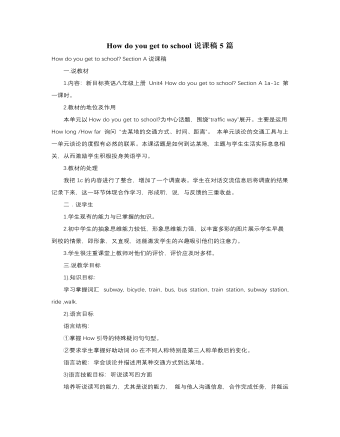
人教版新目标初中英语八年级上册How do you get to school说课稿5篇
难点:1.学会谈论并描述使用某种交通工具到达某地。2.要求学生掌握好助动词do在不同人称特别是第三人称单数后的变化。通过合作学习将听说读写有机地结合起来,切实做到任务密集度适中,节奏合理,环节与环节之间过渡自然,让学生一步步登上高峰突破难点。五.说教学策略:1.教学手段分析:针对低起点的学生,在学习过程中通过“兵交兵,小组训练,鼓励性评价”等扶路措施,提高低起点学生的语言技能。针对高起点的学生要拔高学习目标,同时又能较好地运用到实践中去。2.教学方法分析:本课主要以“任务型教学法”并辅助与情境交际法完成任务的。在教学活动中采用任务型教学法让学生的学习活动具有明确的目标,并构成有梯度的连续活动。学生从注重语言本身转变为注重语言习得,从而获得语言运用的能力。我还采用情境交际法给学生足够的听,说的机会,联系实际,创设情景,在交际中学英语。
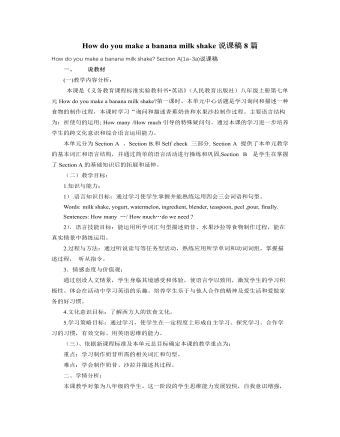
人教版新目标初中英语八年级上册How do you make a banana milk shake说课稿8篇
(五)教学过程1)在课的开始检查学生对单词短语的掌握2)1b,听力为了让学生了解香蕉奶的制作过程,让学生复述,是为了然他们用所学的重点 词汇进行练习、为后面制作水果沙拉奠定基础。3)2a2b的听力是为了复习how much 与how many的区别 ,因为七年级上册unit8涉及到的知识,所以2a2b训练的的真正目的是为了让学生更清楚的了解不可数名词的表达方式 :数词+量词 +of+不可数名词4)在学生完全弄懂事物的制作过程极其不可数名词的数量表达后,我安排他们进行制作水果沙拉的对话。这个对话是机动的,如果时间充足,我让他们按照自己的医院去选择材料进行对话的编排。这个话题既可以用到本科的重点句型,又可用到重点词汇。在这步抓住重点突出难点5)在consolidate 环节,我安排2个汉译英,4个有关how much/how many 的选择,让学生讲做题原因,让他们彻底弄懂不可数名词的数量表达。6)最后,为了加深学生对食物制作过程描述的巩固,让学生把所学知识从口落实到笔头

人教版新目标初中英语八年级下册Would you mind turning down the music教案
Step 4. Group work (4)1. Ask a pair of students to read the dialogue. Say, This activity provides speaking, listening and writing practice using the target language.2. Ask students to complete the work in groups.3. Check the answers with the whole class. 4. Explain some of the language points. Step 5. Word review (Self check 1)1. Ask students to read the words and the phrases given. 2. Fill in the blanks with proper forms of these words to complete the sentences. 3. Check the answers with the whole class. Homework:Do activity 2 on page 57 after class. Period 6Teaching aims: 1. Teach vocabulary words and the useful expressions. 2. Enable the students to learn etiquette in different culture. 3. Help the students learn how to behave politely in public places and in daily life. Teaching procedures:Step 1. RevisionHelp students to review the function of making requests through a free talk. Then lead them to the topic of etiquette. Explain the meaning of etiquette. Or, ask students to look it up in the dictionary. Step 2. Pre-reading (Section 1)1. Ask students to read the picture and make a list with their partner about how many rules of etiquette can be seen being broken.
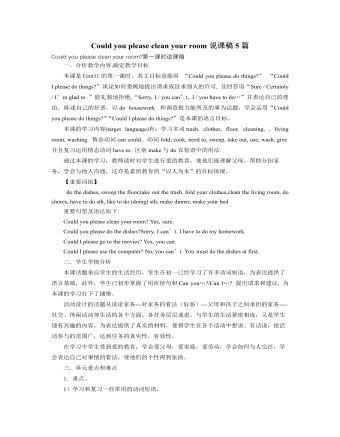
人教版新目标初中英语八年级上册Could you please clean your room说课稿5篇
三、教学准备 复习动词短语,并且预习生词, 游戏用的卡片 小奖品四、说教学方法与手段1.口语教学,在真实的语境下进行对话交际,复习旧知识,认识新事物,学习新内容。2.单词教学游戏化,寓教于乐,让学生学得开心,记得舒心。3. 利用信息沟活动,给学生设置了信息差,激发了学生的询问欲望,真正使语言起到了交流思想的作用。4.听说读写全面训练,从在听说的基础上,发展读写的技能。本节课着重写的能力,让学生从听写单词到看图写句子,由简到难,循序渐进。5.小组合作,师生对话,生生对话。五、说教材处理与学法指导1.将教材内容分为三部分。第一部分为口语操练为主,完成Section B,3,在复习旧句型的前提下学习Could you please clean your room?并能熟练进行对话。2.第二部分是听力练习,训练学生对新学单词的听辨能力和从对话中获取信息并作好记录的能力。4.第三部分是一个写的练习,是对上一节课的语法聚焦的巩固和提高,也是第二部分口头表达的延伸,是学生书面表达的起步。
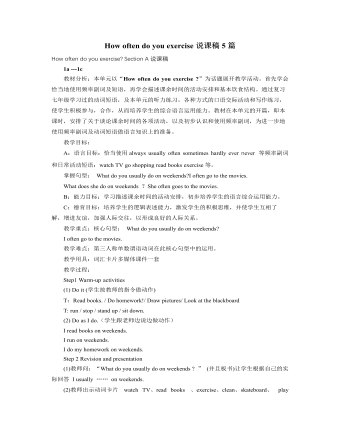
人教版新目标初中英语八年级上册How often do you exercise说课稿5篇
1a ---1c教材分析:本单元以“How often do you exercise ?”为话题展开教学活动。首先学会恰当地使用频率副词及短语,再学会描述课余时间的活动安排和基本饮食结构。通过复习七年级学习过的动词短语,及本单元的听力练习,各种方式的口语交际活动和写作练习,使学生积极参与,合作,从而培养学生的综合语言运用能力。教材在本单元的开篇,即本课时,安排了关于谈论课余时间的各项活动,以及初步认识和使用频率副词,为进一步地使用频率副词及动词短语做语言知识上的准备。教学目标:A:语言目标:恰当使用always usually often sometimes hardly ever never 等频率副词和日常活动短语:watch TV go shopping read books exercise等。掌握句型: What do you usually do on weekends?I often go to the movies.What does she do on weekends ?She often goes to the movies.B:能力目标:学习描述课余时间的活动安排,初步培养学生的语言综合运用能力。C:德育目标:培养学生的逻辑表述能力,激发学生的积极思维,并使学生互相了解,增进友谊,加强人际交往,以形成良好的人际关系。
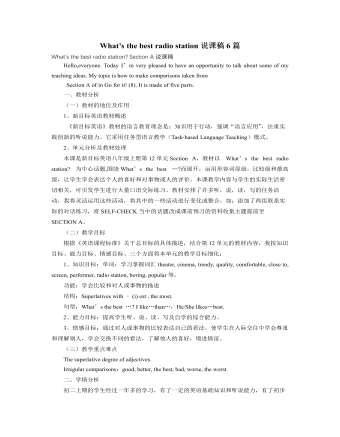
人教版新目标初中英语八年级上册What’s the best radio station说课稿6篇
3、重点和难点:重点:学会用形容词的最高级来对事物或人物进行描述。难点:形容词的最高级加est还是加most.二、 说教法:为了更好的突出重点,突破难点,我主要采用了:1、任务型教学法:新课标倡导的“玩中学,学中玩”的理念很受学生欢迎。例如,阅读文章时,我设计了一张表格,让学生阅读后完成表格并复述。培养学生逻辑分类与表述能力。2、 竞赛教学法:根据初中生争强好胜的性格特征,我每堂课都进行俩俩对话,激发学生兴趣,给学生创造外语语言氛围,培养学生集体荣誉感。三、说学法:1、 善于抓住用英语交际的机会,充分感知,积极体验,大胆实践。例如在导入新课时的One minute dialogue(每组都有一次机会),pairwork (每人都有机会),groupwork(每组一次机会)。2、 积极参与,善于合作。例如本课设计了几个任务,操作简单,学生一定很感兴趣并且积极参与,从而合作完成任务,培养了团队精神。
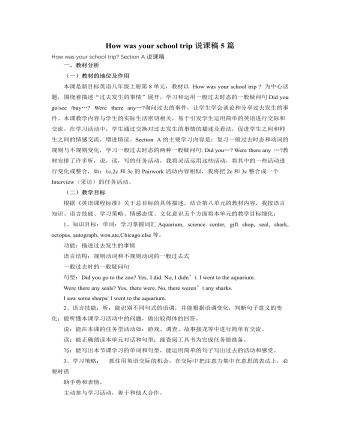
人教版新目标初中英语八年级上册How was your school trip说课稿5篇
If you are sandy,, you want to invite you good friends to come to you party, and you need their help, too..Make a list of things you want to buy and to do first, then discuss in group,act it out..让学生进行评价.评出有特色的“最佳表演”“最佳创意”“最…”小组,给予奖励。6.总结本课的target language.7.Homework.Invite your friends to have a picnic with you, and ask for their help to prepare for the picnic.. make a conversation. 8.教学反思如何激发学生的兴趣, 使他们主动积极地参与活动,开展合作学习, 使课堂充满活力,使设计的每个任务产生实效, 这是任务型教学中的首要问题. 本节课开展小组竞赛, 任务链为:游戏热身( 巩固词汇), 讨论(学习运用句型), 表演(综合运用)等活动, 逐步递进, 从简到难, 从谈论Sally 的周末, 到谈自己一周里所干的家务,电话邀请和请求帮助 ,都是来自现实生活的话题, 极具真实性. 为学生综合表达提供了丰富的素材.让学深入、让学生参与过程的评价体现了以学生为主体的教学理念.
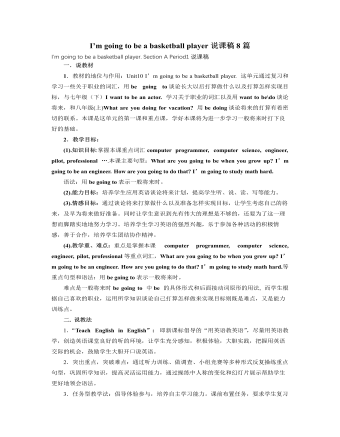
人教版新目标初中英语八年级上册I’m going to be a basketball player说课稿8篇
根据刚才调查和学生的汇报,我们很自然地可以把调查的内容汇编成一篇口头文章。为了更好的指导学生运用be going to 来进行写作,我们可以把课本上的范文给大家朗读一遍,分析如何来写My dream job.然后,可以当堂让学生模仿来进行一篇作文创造,My dream job.【设计意图】最后的写作环节是本课的提升,学生说的都不错,但落实到笔头,总是会出现这样那样的错误。如何让学生运用be going to 来进行作文创作是我们本课的重点和难点。因此很有必要当堂落实。环节6 Summary学生在老师的指导下进行课堂小结。1.重点句型:2.be going to 的用法。【设计意图】教师引导学生课堂小结,既是对文本内容的复习,又是为下节课打好铺垫,同时充分体现了学生是学习的主体地位,增强了学生自主学习的能力,可谓一举多得。
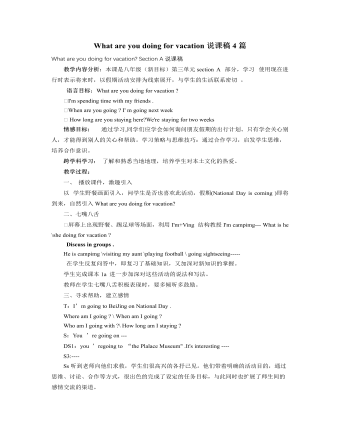
人教版新目标初中英语八年级上册What are you doing for vacation说课稿4篇
这一环节我采用电影《哈利波特》中哈利去霍格华兹的图片引入“how does Harry go to school?” 进而引入” how do you go to school?” 呈现“the ways to go to school” 让学生明确take 的使用及与交通工具的搭配。接着让学生根据实际情况回答自己采用的交通方式,期间可以引入“how does he /she go to school?” 基本了解了怎么说后进入课文,完成1a 部分练习 和1 b 的听力练习。完成后让学生玩一个数字游戏,帮学生回忆数字。通过问学生从家里出发时间和到达时间,引出“it takes ?? minutes .” 的句型。借助ppt 图片进行句型操练。然后完成听力练习2a—2c。本环节用时20分钟。While-task:本堂课的主要任务是让学生运用已学的语言知识,完成一个任务,即计算从学校到上海各种交通工具所需要的时间和费用,讨论应选用和种交通工具和各种优缺点。这一环节将用时10分钟。
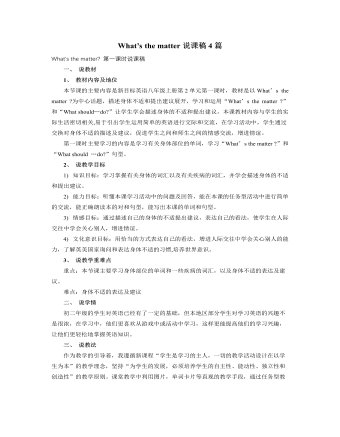
人教版新目标初中英语八年级上册What’s the matter说课稿4篇
在任务环活动中,我通过设计不同的四个任务,让学生在小组中交流、合作、竞争,每个任务都存在着一定的“信息差”,易于激发学生的表达欲望和急于知道最终结果的心情,在活动中他们一定会努力表现自己,做到最好。四个任务所侧重的训练学生的语言能力的要求也各有不同,他们分别侧重训练学生的听、说、读、写的能力。把任务活动放在小组中进行,还可以解决“大班”难于操练的难题,学生在小组中有更多的时间来运用英语表达自己的思想。Post-task任务后活动(4”)1. Grammar Focus(2”)Go through the Grammar Focus with the whole class,ask Ss to point out the main points in this period. Then show the use of The Past Tense on the screen, especially the regular and irregular changes of verbs. 2. Language practice(2”)Practise the sentence patterns and the use of the Past Tense, especially the errors which Ss made while carrying out their tasks. Such as Subject-verb agreement or Tense-agreement, etc. For example: were you see any sharks? He go to the beach. 在学生尽情地参与活动后再让学生反思本节课的语法焦点,并进行适当的操练,对学生在任务活动中的语言失误进行纠正,使学生保持学习信心。语法讲解采用动画形式又保持了学生的学习兴趣。
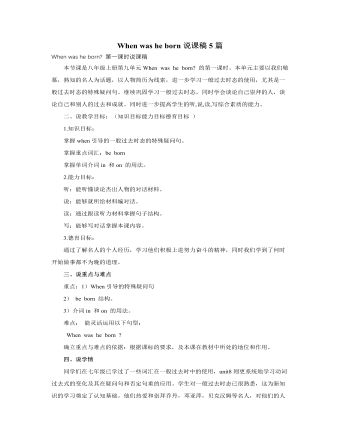
人教版新目标初中英语八年级上册When was he born说课稿5篇
1. 教学重点(1)新单词及目标语言的掌握。(2)听、说、读、写的综合训练。(3)对对合作及小组合作练习口语的训练。2. 教学难点(1)when所引导的特殊疑问句。(2)询问生日与出生年月日的区别。When is your birthday? (一般现在时)When were you born?(一般过去时) (3)表达年月日时所用的不同介词:in+年/月;on+日期二、教学方法。由浅入深,由易到难,由已知到未知,从学生熟悉的运动明星、电影明星甚至是歌手入手,调动他们的学习积极性,让他们在心情愉快、兴趣浓厚的氛围中展开一系列听说读写的训练,主动地投入到学习中去,自然地掌握本单元的重点、难点;循序渐进地深化教学内容,同时以训练学生听说为主,展开以老师为主导,以学生为主体的师生双边互动活动。三、教学手段。利用名人图片来辅助新的语言知识的巩固和训练;采用多媒体教学,并把听力内容录到电脑中,锻炼了学生的视听能力,提高了教学效果。
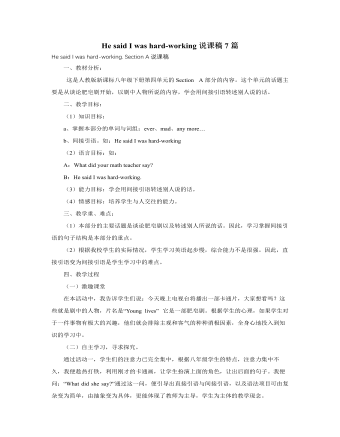
人教版新目标初中英语八年级下册He said I was hard-working说课稿7篇
三、教学重、难点:(1)本部分的主要话题是谈论肥皂剧以及转述别人所说的话。因此,学习掌握间接引语的句子结构是本部分的重点。(2)根据我校学生的实际情况,学生学习英语起步慢,综合能力不是很强。因此,直接引语变为间接引语是学生学习中的难点。四、教学过程(一)激趣课堂在本活动中,我告诉学生们说:今天晚上电视台将播出一部卡通片,大家想看吗?这些就是剧中的人物,片名是“Young lives” 它是一部肥皂剧。根据学生的心理,如果学生对于一件事物有极大的兴趣,他们就会排除主观和客气的种种消极因素,全身心地投入到知识的学习中。(二)自主学习,寻求探究。通过活动一,学生们的注意力已完全集中,根据八年级学生的特点,注意力集中不久,我便趁热打铁,利用刚才的卡通画,让学生扮演上面的角色,让出后面的句子。我便问:“What did she say?”通过这一问,便引导出直接引语与间接引语,以及语法项目可由复杂变为简单,由抽象变为具体,更能体现了教师为主导,学生为主体的教学现念。
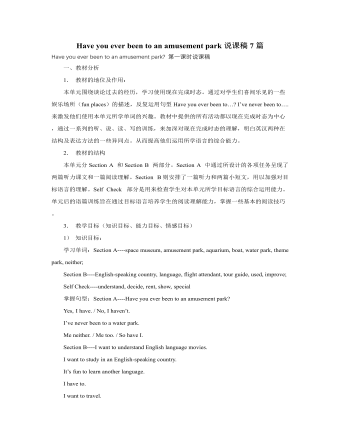
人教版新目标初中英语八年级下册Have you ever been to an amusement park说课稿7篇
1. 教材的地位及作用:本单元围绕谈论过去的经历,学习使用现在完成时态。通过对学生们喜闻乐见的一些娱乐场所(fun places)的描述,反复运用句型Have you ever been to…? I’ve never been to…. 来激发他们使用本单元所学单词的兴趣。教材中提供的所有活动都以现在完成时态为中心,通过一系列的听、说、读、写的训练,来加深对现在完成时态的理解,明白英汉两种在结构及表达方法的一些异同点。从而提高他们运用所学语言的综合能力。2. 教材的结构本单元分Section A 和Section B 两部分。Section A 中通过所设计的各项任务呈现了两篇听力课文和一篇阅读理解。Section B则安排了一篇听力和两篇小短文,用以加强对目标语言的理解。Self Check 部分是用来检查学生对本单元所学目标语言的综合运用能力。单元后的语篇训练旨在通过目标语言培养学生的阅读理解能力,掌握一些基本的阅读技巧。3. 教学目标(知识目标、能力目标、情感目标)
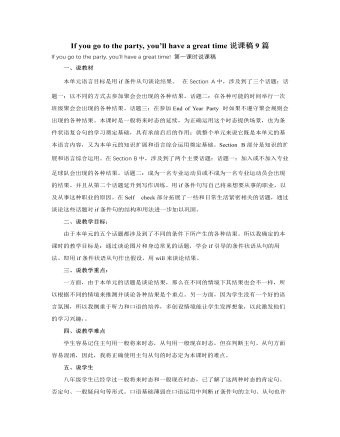
人教版新目标初中英语八年级下册If you go to the party, you’ll have a great time说课稿9篇
二、说教学目标:由于本单元的五个话题都涉及到了不同的条件下所产生的各种结果。所以我确定的本课时的教学目标是:通过谈论图片和身边常见的话题,学会if引导的条件状语从句的用法。即用if条件状语从句作出假设,用will来谈论结果。三、说教学重点:一方面,由于本单元的话题是谈论结果,那么在不同的情境下其结果也会不一样,所以根据不同的情境来推测并谈论各种结果是个重点。另一方面,因为学生没有一个好的语言氛围,所以我侧重于听力和口语的培养,多创设情境能让学生发挥想象,以此激发他们的学习兴趣,。四、说教学难点学生容易记住主句用一般将来时态,从句用一般现在时态,但在判断主句、从句方面容易混淆,因此,我将正确使用主句从句的时态定为本课时的难点。

人教版新目标初中英语八年级下册What were you doing when the UFO arrived说课稿10篇
知识目标:a. 掌握新单词:shout; jump down; climb; scaredb. 掌握并会运用句型:—What were you doing at 8o’clock last night?—I was doing my homework.技能目标:a. 能听懂听力材料的内容,并能做出相应的练习。b. 提高学生听和说的能力。二.教法与学法本节课采取了任务型教学法,通过让学生完成不同的任务来完成不同的教学活动。本节课采用了Brainstorming、Pairwork、Groupwork等活动,实现了让学生说的目标。通过补充故事让学生巩固新学的单词,通过小组的活动让学生参与到问题的讨论中,让学生开口说。三.学情分析通过几个学期的学习,学生已经积累了一定的词汇,并熟练掌握了一些句型。本节课的热身部分是给了学生一个问题:What were you doing at 8 o’clock last night? 通过学生本身的活动来引起他们的兴趣,并对前面的内容进行了复习。四.教学重难点a.掌握本节课所学新单词:shout; jump down; climb; scaredb.掌握和巩固本单元的句型和语法(过去进行时)
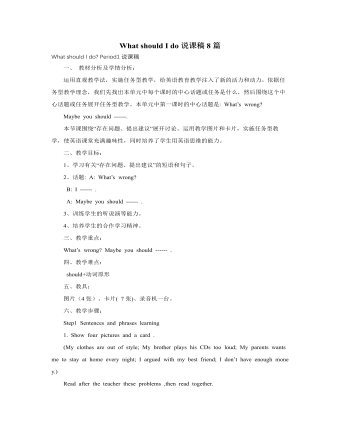
人教版新目标初中英语八年级下册What should I do说课稿8篇
七、教学反思在教学过程中全面培养了学生的英语听、说、运用等能力。直观式教学与任务型教学始终融为一体。通过开展活动,充分调动了学生学习英语的积极性、主动性和创造性。What should I do? Section A说课稿我说课的内容是义务教育课程标准实验教科书《新目标英语》八年级下册第二单元Section A,课题是“What should I do ?”本节说课内容分四个步骤:一、说教材 二、说教法 三、说学生 四、说教学过程。一、说教材(一)教材分析教材的地位和作用:第二单元承接八年级上册What’s the matter?中有关情态动词should 的用法,并作进一步的扩展和综合运用;本课是本单元的第一课时,集中呈现了本单元的基本词汇和语言结构,因此,本课教学有着承上启下的重要作用。(二)教学目标1知识目标:学会使用情态动词should、could,学习并使用新单词2能力目标:(1)能够谈论自己的麻烦和问题。(2)能够为他人的问题找到合理的解决办法,提出相应的建议。(3)能够从他人的建议中为自己的问题找到解决办法。
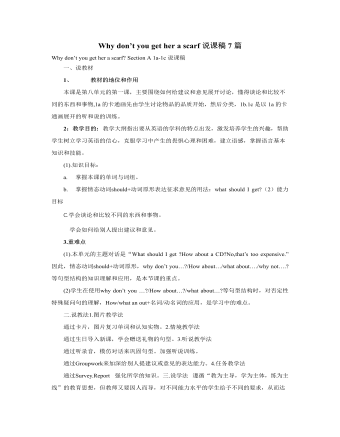
人教版新目标初中英语八年级下册Why don’t you get her a scarf说课稿7篇
[设计意图: 该环节可让学生展示自我,拓宽运用英语能力,把所学的知识在实际交流中进行运用,实现新课程倡导的“为用而学, 在用中学,学了就用”,从而提高学生综合运用英语的能力。选择母亲节来临为母亲选择礼物这一话题也是借此机会对学生进行感恩教育,并在学生的热烈讨论中告诉学生gift can’t be everything, everything can be a gift.使学生的情感得到升华。] Step9 Summary T: What have we learned in this class? Presents/ Gifts Comments Suggestions Album----special Why don’t you … Bicycle----useful Why not … +V原形 Calendar----interesting How about … Scarf----personal What about … +V-ing/ 名词 [设计意图:此环节的设计,有助于理清脉络,进一步巩固所学知识。] Step10 Homework 1. listen to 1b (do 1b and imitate ) 2. Write down your dialogue 3. Surf the internet about the differences of gift giving between China and foreign countries. [设计意图:作业1听力,由于1b听力和后面的2a相似,所以课堂上不再重复做,将其留做课后作业,上课下课时刻关注学生听力能力的培养和训练。2是将学生课堂上的说落实到课后的写。3是让学生通过自主学习,了解中西方文化的差异。分层次布置作业,体现出因材施教的教学理念。]
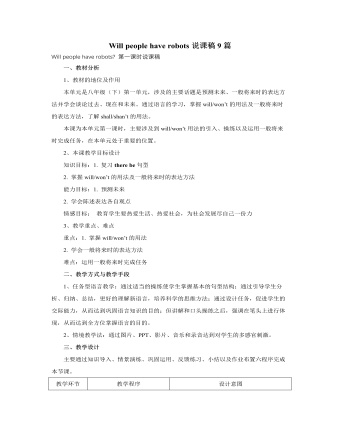
人教版新目标初中英语八年级下册Will people have robots说课稿9篇
(一) 导入新课(1’)运用多媒体课件,播放有关机器人的视频,引起学生共鸣,激发学生学习兴趣。 边看边展示与课文相关的新单词。让学生想像机器人都是什么样的,机器人能做什么?(这样导入新课,自然创设学习情景,引起学生共鸣,引起学生的兴趣。)(二)快速阅读(skimming)(4’)任务:让学生带着要求快速阅读课文:Get the main idea of the whole passage.这个环节是让学生初读课文,目的是训练快速阅读技巧,学生以较快的速度完成阅读,迅速找到答案。(学法指导:注意:用浏览、跳读和快读的技巧,培养自己快速获有用信息的能力---抓住关键词、主题句和中心大意的能力。Tips: Reading for meaning , not for details(细节).不必逐行阅读(三)深层阅读(5’)任务一:默读文章,回答下列问题,我利用多媒体出示2个问题,(把2个问题打出来)然后让学生带着问题进行有目的阅读。(这样做可以充分利用课本资源,而且化难为易.在全班校对答案之前我让学生先进行同桌相互校对,充分发挥生生互动。)
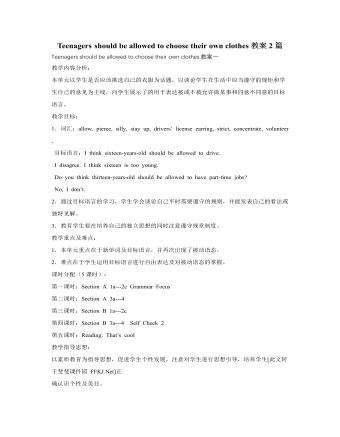
人教版新目标初中英语九年级上册Teenagers should be allowed to choose their own clothes教案2篇
Step 1 Greeting Greet the class and check the homeworkStep 2 A duty report The S on duty gives a report on the rules in his home and lead in 3a “Sun Fei’s and Wu Yu’s rules” Step 3 ReadingSs read the conversation and write the two girls’ rules in the chart. Check the answers.Get Ss to read after the tape and then read aloud by themselves. Then, T explains the language points.Step 4 Pairwork 3bRole play. Use the information in chart to practice with the conversation in 3a covered. They can look at the sample conversation in the right box.Step 5 Task 2 “Who’s the best reporter?”Make a survey by asking any 5 students the questions in the chart in activity 4. Then give out a report about it. See who is the best reporter? And the best reporter will get a nice ball-pen.Step 6 Summary and homework:Write out the report in your exercise-books.Period ThreeStep 1 Greeting and a duty reportThe S gives a duty report talking about his experience of being late for school. Lead in the question “Do you ever get to school late? How often do you get to school late? Always, usually, sometimes, or never?Step 2 1a Get Ss to finish writing.Step 3 Pairwork 1b Get Ss to talk about their answers with their partners using the sample conversation in the box on the right.Step 4 Listening practice2a Lead-in: What will happen if you get to school late? What about Peter? Let’s listen to a conversation between Peter and his father. Get Ss to finish 2a (As usual, for the first time, Ss only listen.) Check the answers.
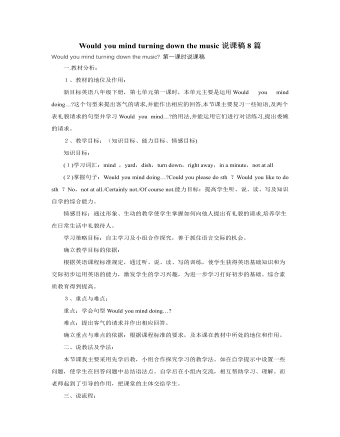
人教版新目标初中英语八年级下册Would you mind turning down the music说课稿8篇
一.教材分析: 1、教材的地位及作用:新目标英语八年级下册,第七单元第一课时,本单元主要是运用Would you mind doing…?这个句型来提出客气的请求,并能作出相应的回答,本节课主要复习一些短语,及两个表礼貌请求的句型并学习Would you mind…?的用法,并能运用它们进行对话练习,提出委婉的请求。2、教学目标:(知识目标、能力目标、情感目标)知识目标:(1)学习词汇:mind ,yard,dish,turn down,right away,in a minute,not at all(2)掌握句子:Would you mind doing…?Could you please do sth ?Would you like to do sth ?No,not at all./Certainly not./Of course not.能力目标:提高学生听、说、读、写及知识自学的综合能力。情感目标:通过形象、生动的教学使学生掌握如何向他人提出有礼貌的请求,培养学生在日常生活中礼貌待人。学习策略目标:自主学习及小组合作探究,善于抓住语言交际的机会。

